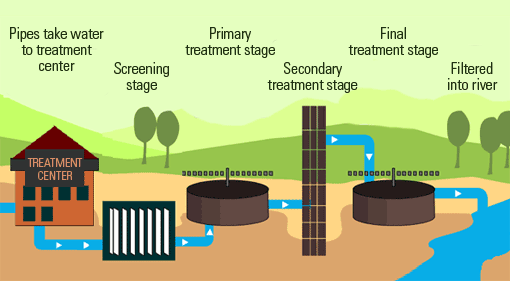Sewage, often referred to as wastewater, is primarily composed of water along with a diverse range of contaminants. These contaminants can include organic matter like human waste, food scraps, and chemicals from households and industries. Additionally, sewage may contain pathogens, heavy metals, nutrients like nitrogen and phosphorus, and various other pollutants. Effective treatment of sewage is essential to remove these contaminants and ensure the safety of water resources and public health. This article discusses various processes involved in sewage water treatment plants, the latest advancements, and the overall significance of the treatment.
What is Sewage Treatment?
The procedure for removing contaminants from the wastewater basically from the household sewage is called sewage treatment. It has to undergo the chemical, physical, and biological procedures to remove these contaminants and give out an environmentally safe treated effluent. A semi-solid slurry called the sewage sludge is the by-product of the sewage treatment. This sludge is further processed before it is suitable for land application.
Sewage treatment is also called as wastewater treatment, i.e. it also includes treatment of wastewater from industries. In many cities, the sewer carries a proportion of industrial wastewater to the sewage water treatment plant which has already undergone a treatment in the factories for reducing the pollutant. If it is a combined sewer it will also carry storm water along with it.
The sewage waters travel to the sewage water treatment plants through pipes and pumps. The sewage in the sewage water treatment plant undergoes the following basic processes.
Anaerobic Sewage Treatment
The sewage is partially decomposed by the anaerobic bacteria in the tank without air. This causes the organic matter to reduce to methane, carbon dioxide, hydrogen sulfide, etc. This treatment is used to treat organic waste and sludge as it provides huge capacity and greatly reduces the input material to a large extent.

Aerobic Sewage Treatment
In this procedure, the pollutants are digested by the aerobic bacteria. In the sewage water treatment plant air is constantly supplied to the bio-zone. The modern-day aerobic sewage plants make use of natural air currents. This process eliminates the pollutants and odors by providing complete oxidation and absorption of organic pollutants and matter into carbon dioxide, nitrogen, and water. The treated effluent is thus pollutant-free and can be discharged for use.
The conventional sewage water treatment plant includes two to three stages namely the primary, secondary, and tertiary treatment. Before the process begins rags, sanitary items, clothes, etc. are removed from the municipal sewage works.
Primary Treatment
In this process, the effluent or sewage flows through huge tanks called primary sedimentation tanks. In these tanks, the sludge settles down while grease and oil float on the surface and are removed. These tanks have scrapers that continuously push the sludge that is collected, towards the hopper in the base of the tank. It is then pumped for the sludge treatment.
Secondary Treatment
In this process, the biological waste from human waste, soap, food waste, and detergent are substantially degraded. Most of the municipal sewage water treatment plants treat the sewage that is settled through the aerobic process. The effluent after the primary treatment has dissolved biological matter. This is then converted into clean water by making use of the bacterial and waterborne aerobic micro-organisms that absorb the pollutants. The effluents from this process are clean enough to be discharged into the rivers.
Tertiary Treatment
This is the final stage of filtration where the effluent is treated further to its best quality before being discharged to the environment. Sometimes the effluent from the secondary treatment is not clean enough. This is because the river or stream it is going to be discharged it may be very sensitive that might have rare plants and animals. Thus tertiary treatment has to ensure very high standards of treating the effluents to be cleaner than the stream or river water. It reduces the phosphorous and ammoniacal nitrogen.
To remove phosphorous a dosing system is used. On the other hand, the removal of ammoniacal nitrogen involves a nitrifying and de-nitrifying process. In this process, the ammoniacal nitrogen is converted to nitrogen gas which is released into the atmosphere thus leaving the effluent clean.
Sludge Treatment
The sludge that is accumulated in the treatment is further treated and disposed of in a safe manner. The sludge is passed through thickeners that dewater it. This sludge is then transported for disposal in a landfill or used for agriculture soil amendment.
Advanced Wastewater Treatment Methods
In addition to conventional treatment methods, advanced technologies are continually being developed to address specific challenges and enhance the efficiency of sewage water treatment plants. These include:
Desalination:
Desalination processes, such as reverse osmosis (RO) and distillation, remove salts and minerals from wastewater, making it suitable for various purposes, including irrigation and drinking water supply. In regions facing water scarcity, desalination plays a crucial role in augmenting water resources.
Sono Arsenic Filtering:
This innovative technology utilises ultrasound waves to remove arsenic from wastewater. Arsenic contamination is a significant concern in many parts of the world, particularly in groundwater sources. Sono arsenic filtering offers a promising solution by effectively capturing arsenic particles and ensuring a safe water supply.
LifeStraw:
Originally designed for personal use in remote areas, LifeStraw technology has evolved to be applicable in wastewater treatment. This innovative filtration method utilises hollow fibre membranes to remove bacteria, parasites, and microplastics from water. Incorporating LifeStraw technology into sewage water treatment plants enhances the safety and purity of treated water. This makes it suitable for various applications, including drinking water supply.
Membrane Filtration Technology:
Membrane filtration involves the use of semi-permeable membranes to physically separate contaminants from water. Processes like microfiltration, ultrafiltration, nanofiltration, and reverse osmosis are commonly employed in wastewater treatment plants. Membrane filtration technology effectively removes particles, microorganisms, dissolved solids, and other pollutants. This produces high-quality effluent suitable for reuse or safe discharge into the environment.
Ultraviolet Irradiation Technology:
Ultraviolet (UV) irradiation is a non-chemical disinfection method used to inactivate pathogens in water. UV light damages the DNA of microorganisms, preventing them from reproducing and causing infections. UV irradiation technology is particularly effective against bacteria, viruses, and protozoa present in sewage. Integrating UV disinfection into sewage water treatment plants provides an additional layer of protection, ensuring the safety and cleanliness of treated water.
Importance of Valves Used in Industrial Wastewater Treatment Methods
Valves play a critical role in the operation and efficiency of industrial wastewater treatment methods. Here’s why they are essential:
- Flow Control: Valves regulate the flow of wastewater within treatment systems, allowing operators to maintain optimal flow rates and prevent hydraulic overloads. Proper flow control ensures each stage of the treatment process operates efficiently, maximising treatment performance and minimising energy consumption.
- Process Optimisation: Different processes require precise control over parameters such as pressure, temperature, and flow direction. Valves enable operators to adjust these parameters to optimise process conditions and achieve desired treatment outcomes. Whether it’s diverting flow between treatment units or adjusting chemical dosing rates, valves play a crucial role in process optimisation.
- Safety: In industrial sewage water treatment plants, safety is paramount. Valves are used to isolate equipment, control hazardous materials, and prevent spills or leaks. Safety valves are designed to automatically relieve excess pressure to protect equipment and personnel from potential hazards. By ensuring proper valve selection, installation, and maintenance, operators can mitigate risks and maintain a safe working environment.
- Reliability: The reliability of valves directly impacts the overall reliability of wastewater treatment plants. Malfunctioning valves can disrupt operations, leading to downtime, reduced treatment capacity, and potential environmental incidents. Investing in high-quality valves and implementing proactive maintenance practices are essential to minimise downtime and ensure the continuous operation of sewage water treatment plants.
Wastewater: A Key Resource To Address Current Challenges
In water management, wastewater is not just a problem to be treated and disposed of. It’s a valuable resource with immense potential to address various challenges facing communities and industries. Here’s how sewage treatment plants play a crucial role in unlocking the potential of wastewater:
Water Scarcity:
With increasing population, urbanisation, and climate change, many regions are facing water scarcity. Sewage water treatment plants enable the recycling and reuse of treated wastewater for non-potable purposes such as irrigation, industrial processes, and toilet flushing. By supplementing conventional water sources with recycled wastewater, communities can reduce reliance on finite freshwater resources and alleviate pressure on water supplies.
Pollution Reduction:
Untreated sewage poses significant environmental risks, including pollution of surface water bodies, contamination of groundwater, and threats to aquatic ecosystems. Sewage plants remove pollutants and pathogens from wastewater, reducing the environmental impact of sewage discharge and protecting water quality. By implementing effective treatment technologies, industries can minimise their environmental footprint and comply with regulatory standards.
Resource Recovery:
Wastewater contains valuable resources such as nutrients, organic matter, and energy. Advanced treatment processes enable the recovery of these resources for beneficial reuse. For example, nutrients like nitrogen and phosphorus can be extracted from wastewater and used as fertilisers in agriculture. Similarly, organic matter in sewage can be converted into biogas through anaerobic digestion, providing renewable energy for onsite use or grid injection. By embracing resource recovery initiatives, businesses can turn wastewater into a valuable asset and contribute to a circular economy.
Climate Resilience:
Climate change is exacerbating water-related challenges, including droughts, floods, and water quality degradation. Sewage water treatment plants play a vital role in enhancing climate resilience by providing alternative water sources and mitigating the impacts of extreme weather events. By diversifying water supplies and improving water management practices, communities can adapt to changing climatic conditions and ensure water security for future generations.
Book a Free Consultation for Customised Solutions
FAQs
How does a sewage water treatment plant work?
Sewage treatment plants employ a combination of physical, biological, and chemical processes to remove contaminants from wastewater. These processes include screening, sedimentation, biological treatment, filtration, and disinfection.
What are the benefits of investing in a sewage plant?
Investing in a sewage water treatment plant offers several benefits, including compliance with environmental regulations, protection of public health, resource recovery opportunities, and potential cost savings through water reuse and energy generation.
What factors should businesses consider when selecting sewage water treatment technologies?
When selecting sewage water treatment technologies, businesses should consider several factors. These include treatment efficiency, scalability, cost-effectiveness, ease of operation and maintenance, regulatory compliance, and compatibility with existing infrastructure.
How can businesses optimise the performance of sewage water treatment plants?
Businesses can optimise the performance of wastewater plants by implementing efficient treatment processes, conducting regular maintenance and inspections, monitoring key performance indicators, and investing in staff training and capacity building.
What are the emerging trends and innovations in sewage water treatment technology?
Emerging trends in sewage water treatment technology include:
- Adoption of decentralised treatment systems
- Integration of advanced sensors and automation
- Development of energy-efficient treatment processes
- Exploration of nature-based solutions such as constructed wetlands and algae-based treatment systems.
Book a Consultation for a Custom Sewage Water Treatment Solution for Your Plant
Ready to revolutionise your sewage water treatment plant? Book a consultation now to explore tailored solutions that align with your plant’s unique needs and challenges. Our team of experts will work closely with you to design a customised wastewater treatment solution that maximises efficiency, minimises environmental impact, and ensures compliance with regulatory standards.
Invest in a personalised strategy that optimises performance and enhances sustainability. Contact us at +91-9558996411 or email us at info@cleantechwater.co.in to take the first step towards a cleaner, greener future by scheduling your consultation today. Your sewage water treatment plant deserves the best – let us help you achieve excellence.
You might also want to check our related posts:

